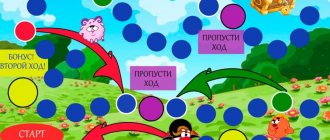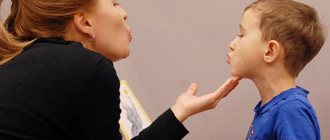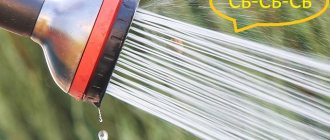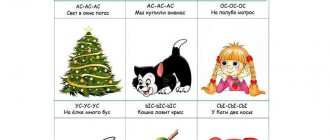Interactive manual for preschoolers. Automation of sound [l] in words
Multimedia presentation for automating sound [l] in words
Author: Radulova Svetlana Mikhailovna, teacher-speech therapist, Municipal Educational Institution “Bendery Kindergarten No. 9”, Bendery. Description of work: A multimedia presentation was developed for individual lessons with preschoolers who have impaired sound pronunciation. This material will be useful for speech therapists and parents in working with children to automate the sound [l] in words with open, closed syllables and consonant clusters. Goal: automation of the sound [l] in words. Objectives: Practice correctly pronouncing the sound [l] in words.
Practice forming the nominative and genitive plural forms of nouns. Practice the correct formation of the genitive case forms of nouns. Practice agreeing nouns with numerals and possessive pronouns. Practice forming diminutive forms of nouns. Develop logical thinking and attention. Cultivate perseverance, a desire to study, and develop self-control over your speech. In children with general speech underdevelopment, the formation of all components of the speech system is disrupted. In individual lessons, the speech therapist teacher needs to pay great attention to enriching and activating the vocabulary, the formation of grammatical structure, and the development of inflection and word formation skills. Words with automated sounds are introduced into lexical and grammatical exercises. Throughout the entire lesson, the child should have a persistent positive emotional attitude, which is expressed in the desire to study. This is achieved by using game tasks and exercises. Presentation for automating sound [l] in words contains animations and triggers. On each slide in the upper right corner there is a control button: the document in which the task is given. When you click on the text with the task, it disappears. Automation of the sound [l] in words with a closed syllable (slides 2-6).
Slide 2. “Name the pictures” - Pavel asks to name the objects. The child clicks the mouse on the slide and names the pictures: hall, glass, pencil case, station, floor, goal, stake, table.
Slide 3. “Name the pictures” - Pavel asks to name the objects. The child clicks the mouse on the slide and names the pictures: blow, chair, chalk, torch, cauldron, donkey, goat.
Slide 4. “What did Paul see?” The slide has triggers on the pictures: shelf, bun, Christmas tree, lightning, bottle, violet. - Pavel asks riddles: Wooden, long... (shelf), glass, green... (bottle), sweet, soft... (bun), green, prickly... (Christmas tree), fragrant, fragrant... (violet) - Name the objects you saw Paul. The child clicks the mouse on the picture and names: shelf, bun, Christmas tree, lightning, bottle, violet.
Slide 5. Game “The Fourth Wheel” The slide has triggers in the pictures: table, shelf, chair, fork. - Find the extra item and click on the picture. (Fork).
Slide 6. Game “The Fourth Wheel” The slide has triggers in the pictures: wolf, woodpecker, goldfinch, falcon. - Find the extra item and click on the picture. (Wolf).
Automation of the sound [l] in words with an open syllable (slides 7-12).
Slide 7. Game “One and Many” On the slide there are pictures: llama, paw, lamp, boat, magnifying glass, next to which there are images of clouds. - Lada names one object, and you name many of the same objects. The child clicks the mouse on the cloud and names the pictures according to the example: llama - llamas - many llamas paw - paws - many paws lamp - lamps - many lamps boat - boats - many boats magnifying glass - magnifying glasses - many magnifying glasses
Slide 8. Game “Name it kindly” The slide has triggers in the pictures: bench, boat, palm, fist, dove. — Alla is affectionately called Allochka. Name things affectionately. The child clicks on the pictures, which decrease in size, and names: bench - bench boat - boat palm - palm fist - fist dove - dove
Slide 9. “At the Zoo” The slide has picture triggers: llama, horse, elk, donkey, goat, pigeon, falcon. — Mila came to the zoo to photograph animals. Name the animals and birds that Mila saw. (Mila saw a llama, a horse, an elk, a donkey, a goat, a dove, and a falcon).
Slide 10. Game “What’s missing?” The slide has triggers in the pictures: saw, rock, tent, salad, pin, robe. - Click on the picture and tell me what’s missing? (The saw, the rock, the tent, the salad, the pin, and the robe were gone).
Slide 11. “Count the Sharks” The slide shows an image of the ocean. - Click on the slide and count: one shark, two sharks, three sharks, four sharks, five sharks.
Slide 12. Game “The Fourth Wheel” The slide has triggers in the pictures: horse, doll, lamp, shovel. - Find the extra item and click on the picture. (Lamp).
Automation of the sound [l] in words with a combination of consonants (slides 13-15).
Slide 13. “Mine, mine, mine, mine” The slide has picture triggers: globe, doll, dress, apples, ball, strawberry, flag. - Alla names his objects. Click on the picture and name it according to the example: my globe (my doll, my dress, my apples, my ball, my strawberry, my flag).
Slide 14. “Collect apples” The slide has triggers on apples. - Count how many apples Alla has. Click on the apple and count: one apple, two apples, three apples, four apples, five apples.
Slide 15. Game “The Fourth Wheel” The slide has triggers in the pictures: blouse, raincoat, scarf, dress. - Find the extra item and click on the picture. (Handkerchief).
I hope that the material will be useful in the work of teachers.
Presentation on the topic: Automation of sound [l] in words
We recommend watching:
Speech therapy games for preschoolers Do-it-yourself speech therapy board games for kindergarten Interactive manual for kindergarten. Automation of the sound [l] in phrases and sentences Interactive guide for differentiating the sounds [l] - [r] in syllables and words for preschool children
Similar articles:
Speech therapy games for preschoolers and primary schoolchildren
DIY speech therapy games for preschoolers
DIY speech therapy games
Speech therapy game for older preschoolers
Speech therapy game for children 5 – 8 years old “Who is faster”
Useful tips
- At the beginning of each lesson on automating the sound “L” we conduct 2-3 articulatory gymnastics exercises.
- During the lesson, ensure the correct articulation of the sound “L” (see articulatory gymnastics).
- Classes are held regularly for 20-25 minutes depending on the age of the child and alternating play exercises.
- At the first signs of fatigue, take a physical minute. Kinesiological exercises are very useful for relieving tension and emotional relaxation.
- Classes should be conducted in a friendly and comfortable environment for the child.
- If the child has already mastered the correct pronunciation of the sound “L”, then the lessons can be made active. Walk, climb, jump, repeating rhythmic phrases. Learn them and use them. like counting rhymes, songs, etc.
Automation of the sound “L” in pure phrases, as in sentences, develops associative thinking. The child needs to match each word with the picture and name it.
Mnemonic tracks of pure tongues will also introduce children to prepositions and will be able to visually designate this “invisible” word using model diagrams.







